I was recently interviewed by Phil Williams about my many years fishing for grey mullet. Take a listen if you have any interest in these hard fighting and at times frustrating fish.
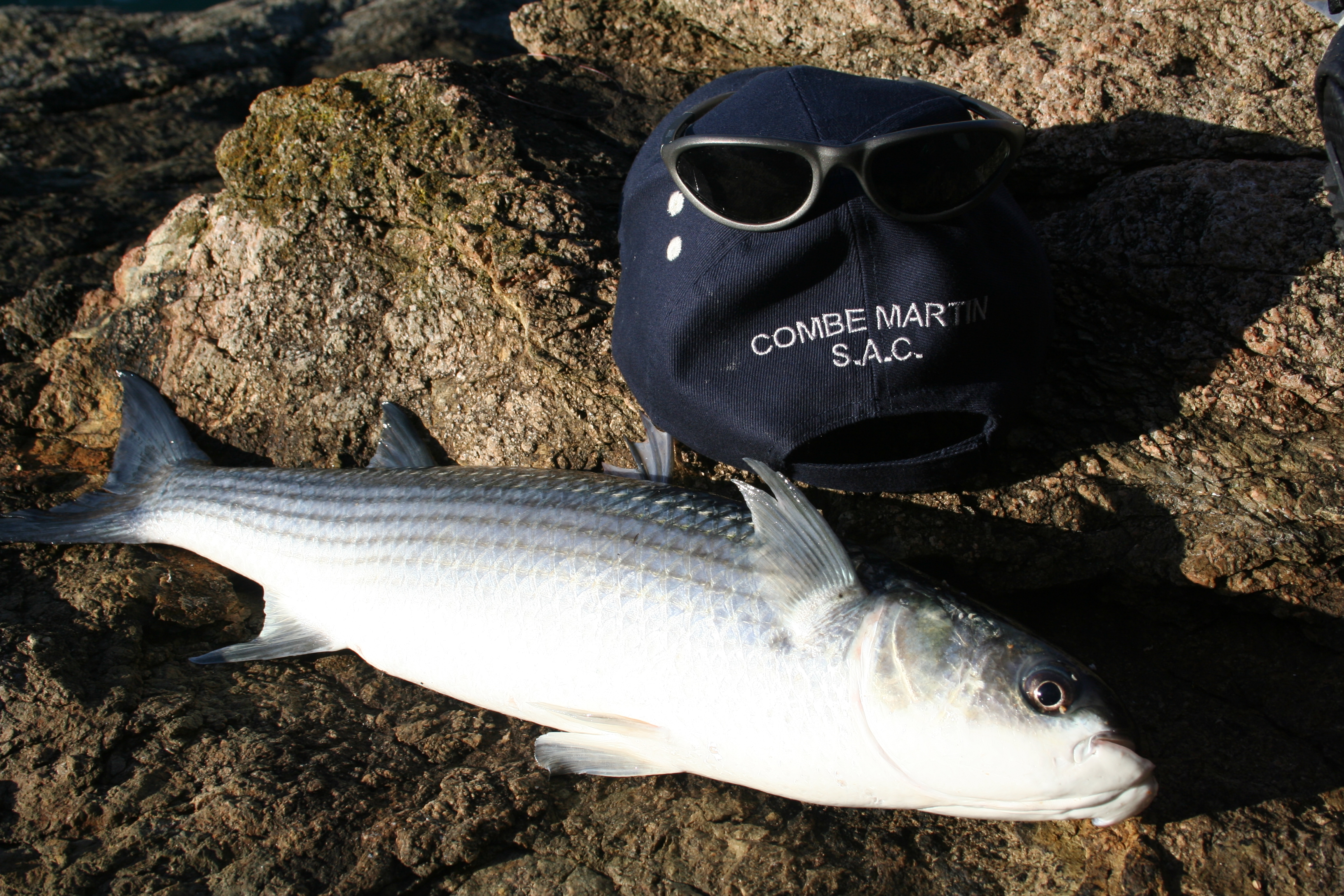
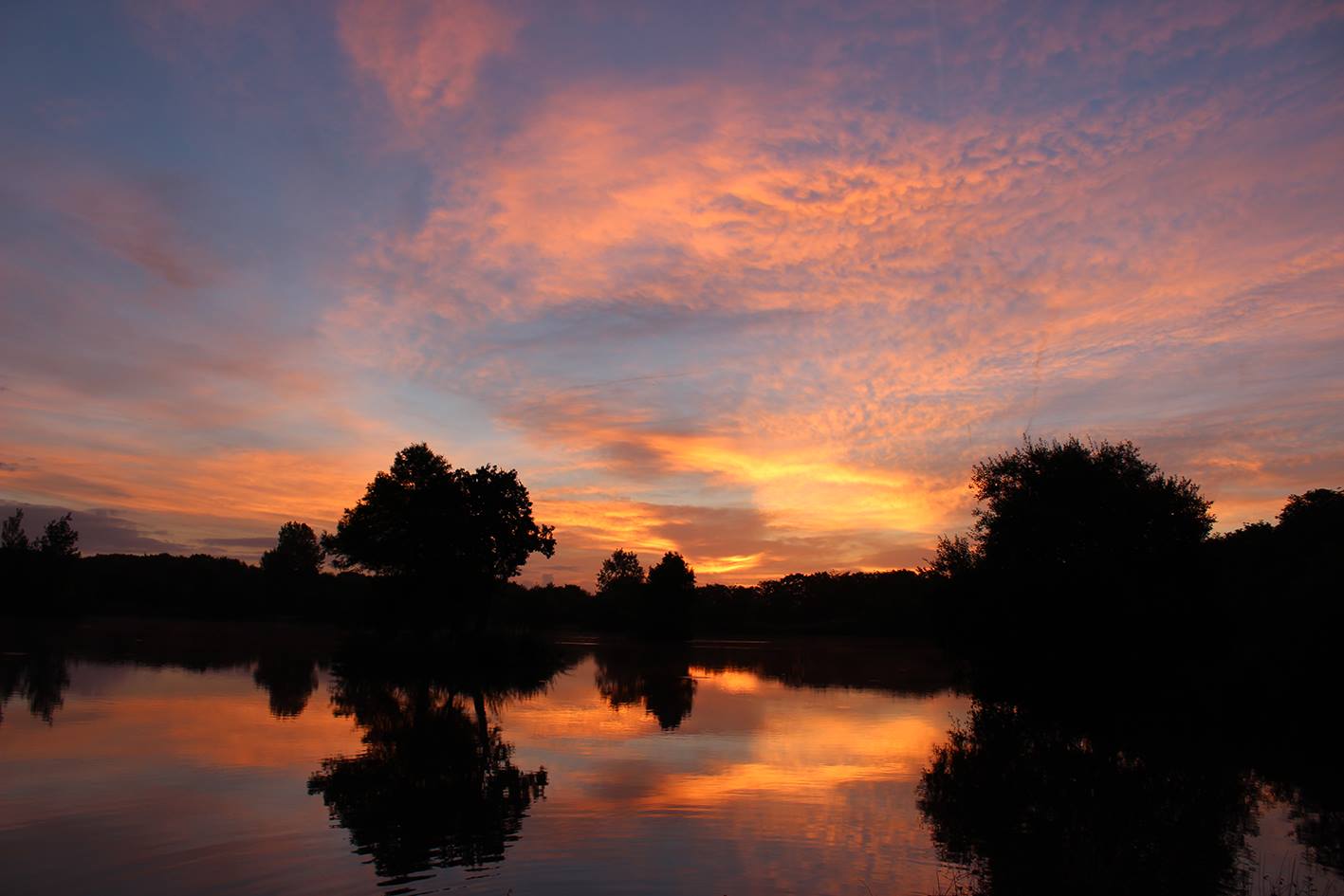
Steve Pinn spends many hours fishing for carp mostly at Stafford Moor and he combines his fishing with his love of photography. I asked Steve if he would put a few words together and share some of his stunning images. These illustrate the real joy of fishing and carp fishing in particular where the angler is within the environment letting the seasons and days roll by observing each changing mood as the world revolves.
Through the lens by the Steve Pinn the BIvvy Tramp!
When “bivvy’d up” for several nights in the heart of the beautiful Devon countryside, I’ve always said that catching a fish is a bonus. Carp fishing is a waiting game, one that can keep you awake all hours but one that allows you to see and hear things that not everyone is privileged enough to witness. Magenta sunrises, sunsets, cloud formations, changing seasons and all manner of natural splendor never fail to delight and, for me, capturing those moments is just as important as the ‘trophy carp shot’. You really don’t need the best camera in the world, I use my iPhone just as much as my Canon SLR, but to not record more than just your latest catch when you are surrounded by such a visual feast would, to me, be a tragedy. Get snapping, you won’t regret it.












A tumbling river in springtime with the smell of ramsey and birdsong filling the air has been a part of my life since I was a child catching crimson spotted brown trout from the River Umber that runs through the village of Combe Martin. A few weeks ago I found myself looking into the river where I first tempted those spotted trout. Sadly there were no signs of the descendants of those trout which is a sad refection on the waning state of our countryside.

Fortunately there are still plenty of rivers in North Devon that still have healthy populations of trout. I took a wander along my local river wielding a split cane rod I had bought from a work colleague. The old scottie rod had been bought at a car boot sale and I later found that the rod had been taken there by Richard Mann who I had fished with on several occasions at Blakewell Fishery. Richard was a very enthusiastic angler who had fished far and wide with many a tale to tell. In latter years he had done a huge amount of work for a local branch of the Salmon and Trout Association. Richard sadly passed away last year.

I flicked the flies upstream and thrilled as the free rising trout seized the fly. The old rod flexed as the trout gyrated and darted to and fro in the clear water. I wondered what other adventures the rod had been on? It didn’t really matter what rod as the small river didn’t demand distance casting, a bit of precision perhaps. A modern carbon rod could have ticked every box in functionality but perhaps the old rod was more in keeping with the late spring evening? The river had those same characteristics I had enjoyed close to fifty years ago, perhaps that is one of angling’s greatest attributes in that it brings back those childish perceptions and feelings.


A couple of nights later I was casting a fly across the River Torridge in hope of salmon. The river had dropped away but still had a nice tinge of colour. I started hopeful but as the evening swept past I felt slightly melancholic at the lack of salmon surely after the recent spate there would be salmon present? It was a glorious evening full of birdsong and riverside aromas. I did catch one or two glorious spotted brown trout but these were not enough tonight for I had set my expectations higher and with that came a slight feeling of failure. I will of course be back casting again full of expectation next time the river rises and brings fresh hope of silver tourists.


At the end of March I attended the Torridge Fishery AGM where we were given a fascinating presentation by Izzy Moser of the Devon Wildlife Trust. I spoke with Izzy the following day at the Riverfly training event when she kindly offered to share information on the efforts to restore freshwater mussels. I have thrown together a few information leaflets and some of Izzy’s notes from the slide show to give an overview of the project and the fascinating life cycle of the mussel. The project is supported by Blakewell Fishery.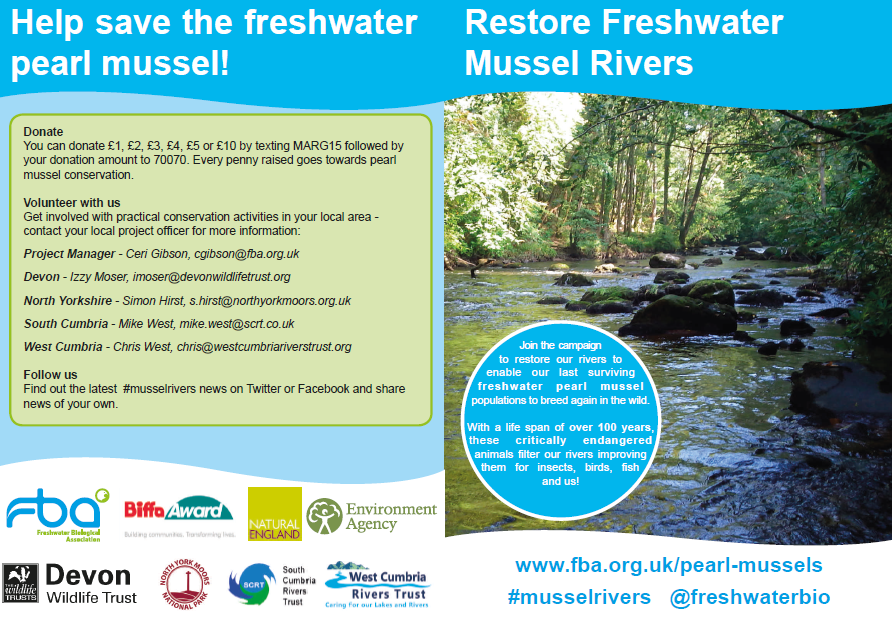
This project has been set up in north Devon’s river Torridge
The aim of the project is to protect and restore FPM populations, and with this, to improve water quality for all users of the river.
Broader water quality issues – for example, pollution (soil, nutrients, pesticides), acidification, heavy metal inputs… and how we can improve these.
Partner project – Biffa funded etc.

Margitifera Margatifera – latin name
Freshwater Pearl Mussels are filter feeding bivalves from the group mollusc. They are one of the longest living invertebrates known (they can live over 100 years) and they inhabit the beds of rivers in the UK. According to the documentation, the require clean, well oxygenated, fast flowing waters
Filter 50 litres of water /day. In large numbers they can help to improve water quality through filtration.
Part of their life cycle is spent attached to the gills of salmonids (brown trout and Atlantic salmon, so good populations are vital to the survival of juvenile mussels.
Currently most of the populations are in Scotland but FPM were once widespread across the UK and could be found in the Tamar, Exe, Dart, Teign, Taw and Torridge. Currently, the only know populations are in the Taw and Torridge and these are relatively low numbers.
On the Torridge there estimated to be around 2000 individuals and this makes up the 4th largest colony in the UK.
However, these mussels are not thought to have breed successfully since the 1960’s, and are therefore aging significantly.
FPM critically endangered and nationally protected.
Genetically different from populations in northern England.
Thriving mussels populations can help to improve water through filtering
Thriving mussel populations are a sign of healthy rivers.

The West Country Fly Fishing Seminar 2017

Close to seventy fly fishers from novice to expert assembled at the Fox and Hounds, Eggesford for the annual West Country fly fishing seminar all keen to learn more about the art of fly fishing. Fortunately it was a warm spring day with new growth bursting forth on the trees and recently arrived swallows swooping around the old fishing and hunting hotel.
The event is hosted in a collaboration between the Devon School of Fly Fishing and Fly Fishing Tackle.co.uk who are based locally in Crediton. There were a team of expert guides from all over the country to assist in the delivery of talks, demonstrations with tuition on casting, watercraft, fly selection and a whole lot more relating to fly-fishing.

The morning commenced in the meadows beside the Upper Taw where Peter Tyjas (Above) opened proceedings with an informative talk on the event and aspects of fly-fishing including tackle and his undoubted passion for casting a fly in various waters; especially for the wild brown trout that swim in the Upper Taw.
The guides present included:-
Jim Williams
AAPGAI MASTER level fly fishing & fly casting instructor, Sales manager for Vision Flyfishing UK
Jim Fearn
AAPGAI qualified salmon casting instructor and Rio Pro-Guide. He is responsible for product development at Guide Flyfishing who distribute RIO Lines, McLean Nets, Redington, Fishpond, Loon
John Legg
Managing Director at Guide Fly Fishing and AAPGAI level instructor.
Pete Tyjas
AAPGAI qualified instructor and principal of the Devon School of Fly Fishing, together with his team of fully qualified guides.

During the morning session each of the instructors gave a talk on their area of expertise with casting demonstrations that included in depth advice on spey casting, double haul timing, casting the perfect loop and the need for practice.
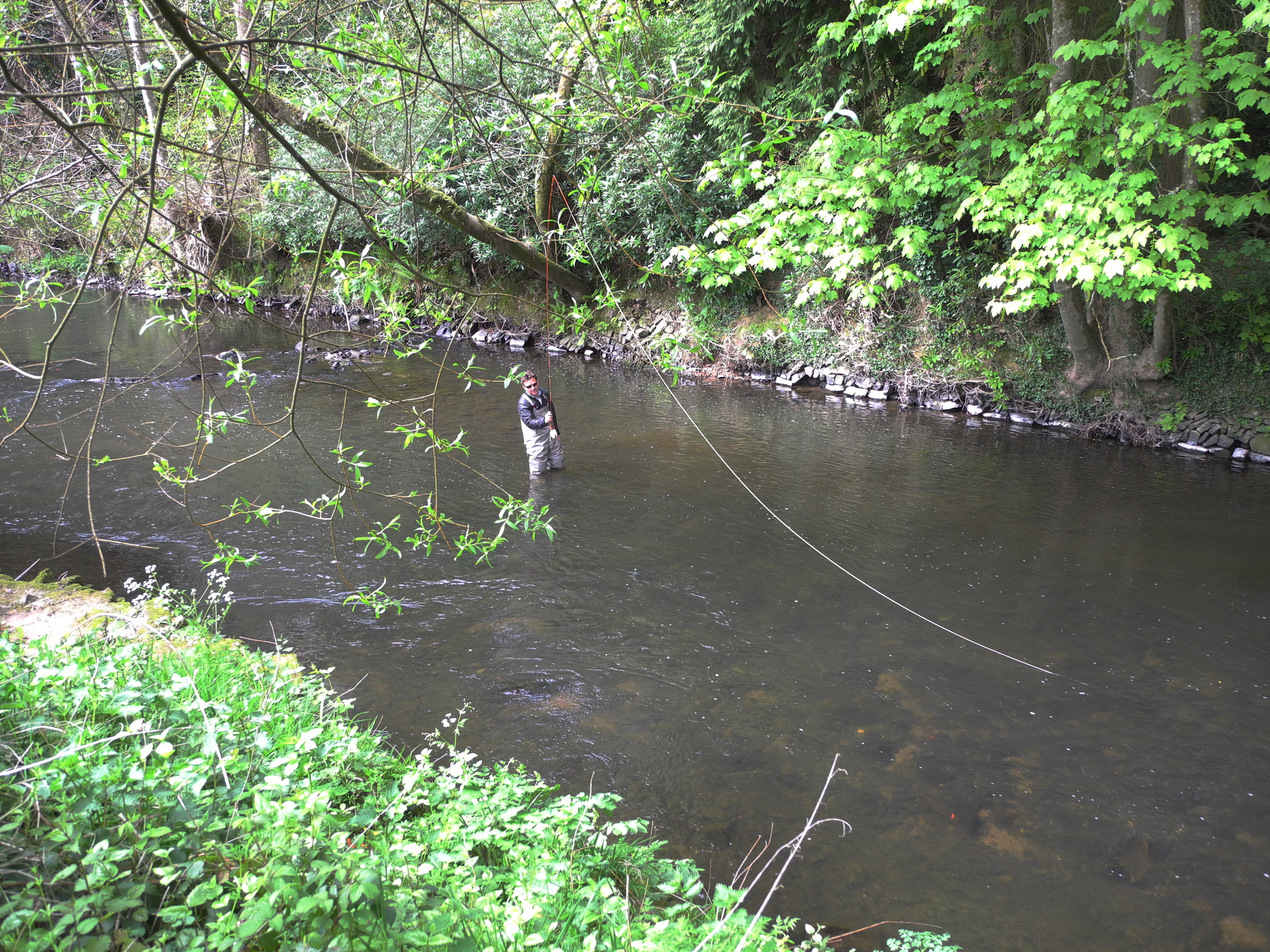
After these extensive and fascinating displays and talks the anglers were encouraged to assemble into relevant groups where they could receive relevant tuition dependent upon their knowledge or avenue of interest. There was also the opportunity to handle and cast the latest fly rods with lines and reels.

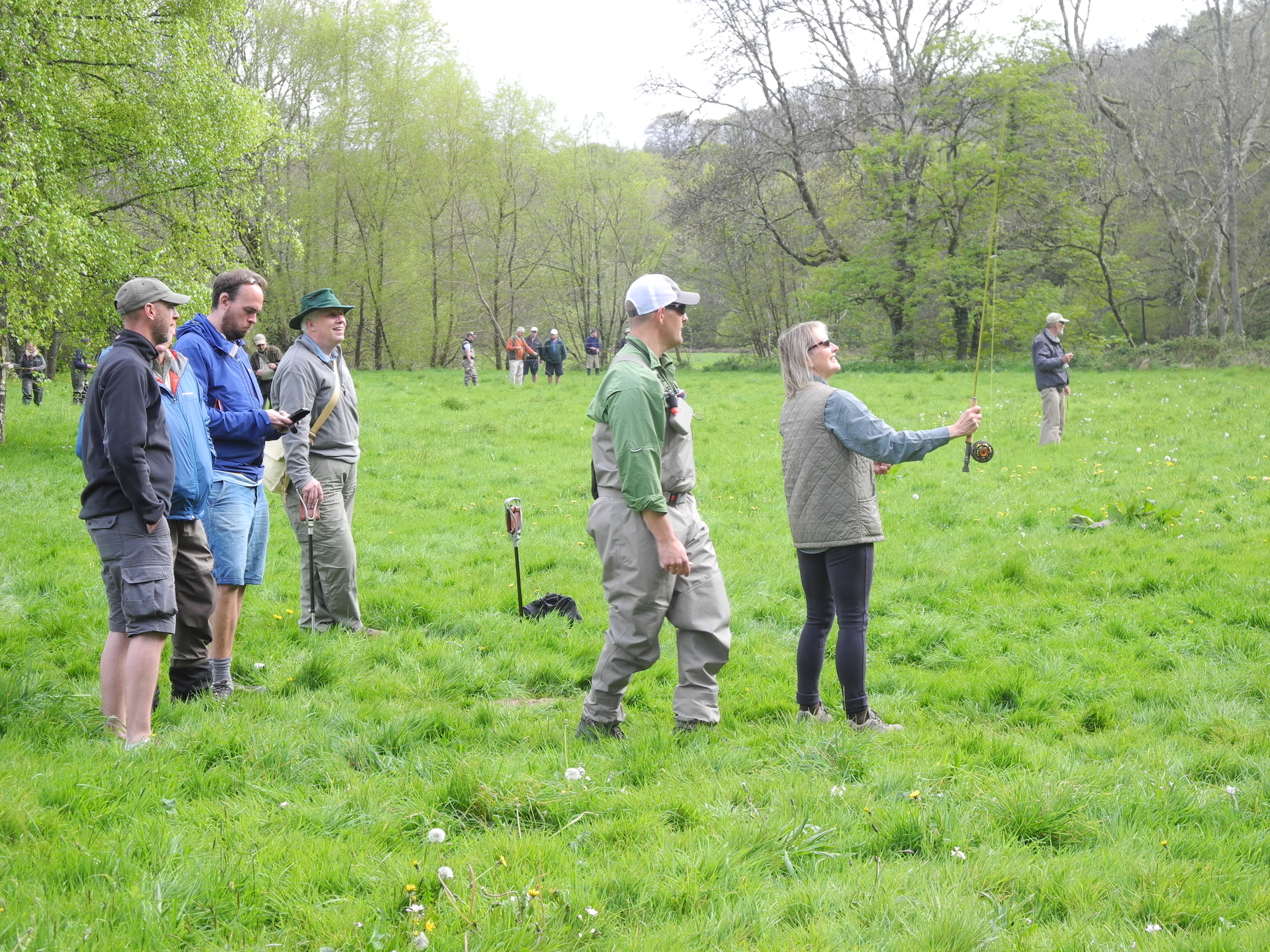
Lunch time gave the opportunity to mix and mingle in the dining area of the hotel and to have a drink in the bar where hundreds of old photos of salmon catches of bygone days decorate the walls.
After lunch it was back to the meadow where at this point the guides got into the river to talk about watercraft and the wide range of techniques available to the fly-fisher. Dry fly fishing, New Zealand style presentation, czech nymphing and American style streamer fishing. Whatever style you choose observation of the waterside environment is vital with weather, water condition, temperature and light values likely to impact upon the food available to the fish we seek. In addition to this watercraft is valuable in providing an educated guess as to where the fish are likely to be. All the above factors will influence the tackle required. Though in reality it is impractical to carry all the rods and reels required for each technique and presentation compromise is therefore required for most of us.

The choice of fly or lure is of course important but the need for a vast range is generally not required as presentation and positioning are of more value. The importance of the leader is also an important but often overlooked component in the link to presenting the fly correctly. Tapered leaders aid good presentation with a stiff butt leading to a fine tippet via the middle transition section. One of the key factors in dry fly presentation is of course ensuring a drag free drift.

The guide giving my wife Pauline tuition told us that the key areas to consider when fishing for trout are: –
Presence – Not alerting the fish to your presence
Presentation – Presenting the fly in a natural manner
Pattern – Choosing the correct imitation on the day
By the end of the day we had been given a huge amount of information and thought provoking ideas. Success in angling is undoubtedly boosted by attention to detail and the best anglers fine tune their tactics to suit the fish they seek, I realized that despite being an angler for over fifty years I know very little about the sport I love. Being an all-rounder I must concede that I will never be an expert in any discipline of angling if such a thing exists. In angling it is the fish that write the rule-book and the only certainty within that book is that fish don’t always follow the rules.
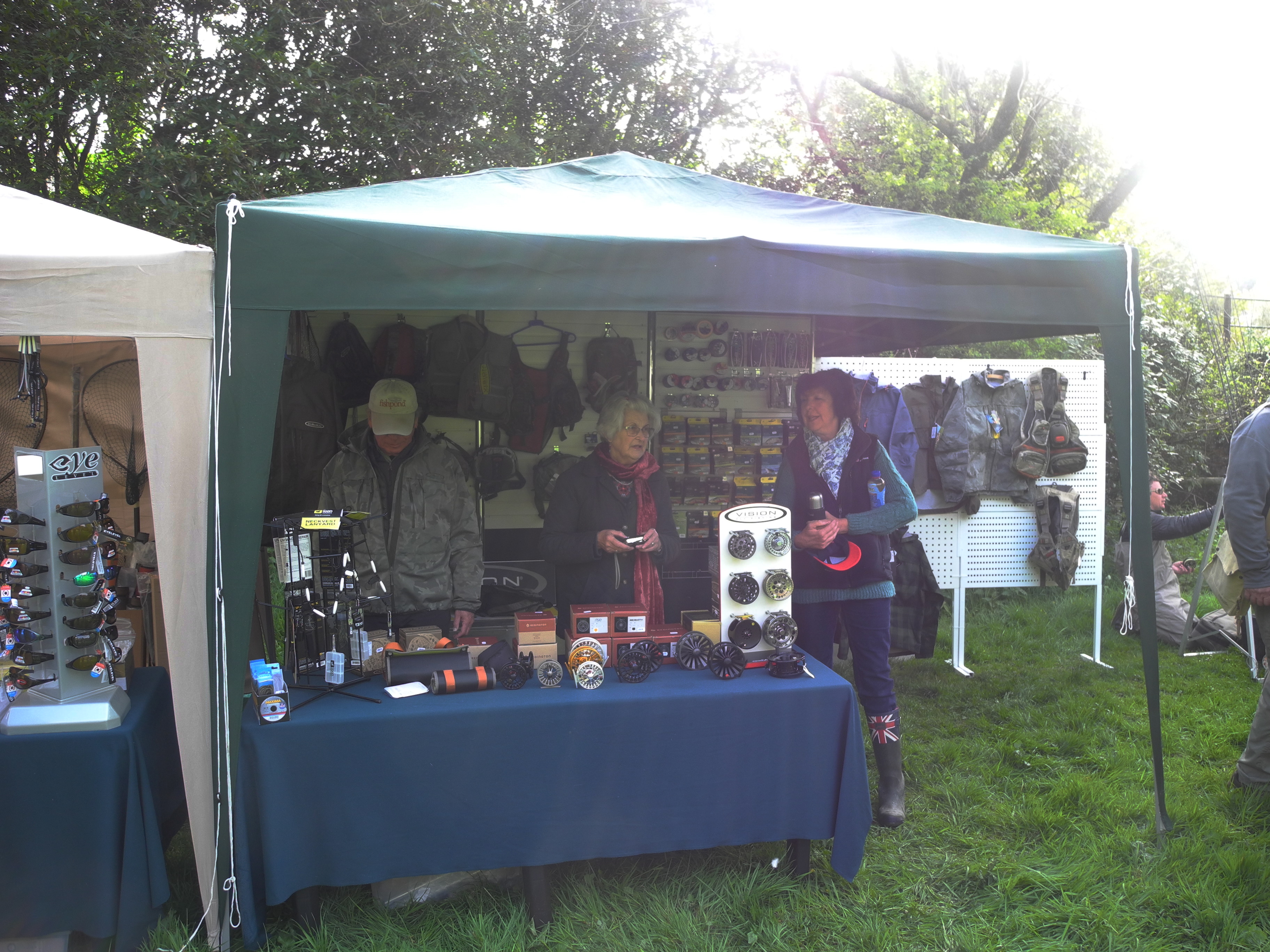
Fortunately we have a vast range of waters in North Devon to practice on and I look forward to casting a line far and wide this coming year. Hopefully with her recent tuition Pauline will also connect with the wild fish that swim in river, stream, lake and sea.
The River Fly Partnership
“Riverfly Partnership tutors deliver one-day workshops to fishing clubs and other organisations committed to establishing a group to monitor the biological water quality of their local waters.
Anglers are natural guardians of the river environment, and are in an ideal position to monitor the health of the watercourses they fish, by using the riverflies they aim to imitate with their artificial flies. Many angling and other interested groups expressed an interest to be able to carry out health checks on their waters. The Riverfly Partnership spearheads an initiative to allow interested groups to take action that will help conserve the river environment. This initiative provides a simple monitoring technique which groups can use to detect any severe perturbations in river water quality and puts them in direct communication with the local Ecological Contact of the Environment Agency (EA) / Scottish Environment Protection Agency – participating areas (SEPA) / National Resources Wales (NRW) / Northern Ireland Environment Agency (NIEA). “
I joined a group of enthusiastic volunteers for a days training on the River Fly Initiative at The Fox and Hounds Country Hotel near Eggesford. The course was run in conjunction with the North Devon Biosphere and our tutor’s for the day were Matthew Edworthy from the North Devon Biospere and Izzy Moser from the Devon Wildlife Trust.
The group of volunteers was a mix of anglers and members of the community with a passion for Devon’s wildlife. All understood the importance of a healthy river and how the river fly population can act as a natural barometer to its health. Fly Fishers of course have a long established link to a rivers fly life as it is these creatures that the anglers mimic when trying to tempt the trout that live within the river.
It was observations by anglers that had helped to establish the vital link between the abundance of fly life and the richness of the river habitat. Observations over many decades revealed an alarming decline in fly populations. It was this that had lead to the River Fly Initiative.
The sampling of a section of river and careful gathering of data relating to fly life populations is a proven way of detecting any decline in the river health. This can show up problems long before any fish kill or visible signs of an issue.
The first part of the day was spent in the classroom where we were given a thought provoking briefing on health and safety and the risks we may encounter at the waters edge including the ever-present threat of Leptospirosis/Weils disease and lyme disease. We were then briefed on the identification of the fly groups we would be looking for within the river.
Caddisfly (sedge) larvae – Cased Caddis Caseless caddis
Up-wing fly larvae – Mayfly Ephemeridae , Blue-winged olive, Flat-bodied Heptageniidae, olive Baetidae
Stonefly Larvae Stone Flies
Freshwater Shrimp Gammarus
The life cycle of these river dwellers proved to be a fascinating insight into the rich variety of the life within our rivers and as an angler for close to fifty years I was somewhat dismayed at my lack of knowledge. Though this was one of the reasons I had enrolled on the course as knowledge of the river life enhances each day spent by the waters edge fishing.
The previous night had seen heavy rain fall over much of North Devon resulting in a brown and swollen River Taw. It seemed that our all-important practical session would be impacted upon but fortunately one of our party owned a delightful property with a small stream running through its meadow. After lunch we all tramped down to the river with our nets and buckets. Along the way we were delighted to see numerous rare snakehead fritillary flowers in the meadow.
It was refreshing to share in the joy of messing around in the river with a group of like-minded people. Whilst the exercise had a valuable purpose I could not help but remember childhood days spent exploring a babbling brook. My angling life began with this fascination for rivers and the life within.

The sampling method involves 3 minutes of intense riverbed kicking and a minute of rock turning. This resulted in several buckets full of river life and detritus to take away and analyze.
To our delight it soon became apparent that we had struck upon a rich vein of river life with all our target species present in good numbers. Sorting the fly larvae into their respective groups proved a fascinating exercise and there were plenty of enthusiastic exclamations as various larvae were revealed.
We returned to the Fox and Hounds for a briefing on logging our data and how this vital information would be used by the Environment Agency to monitor river health. There is of course a political background to this citizen science for a significant reduction in funding means that those that care about the environment have to get out there and work for the protection of the riverside habitat. It is my belief that the rivers are the arteries of our green and pleasant land. As an angler I of course have an additional link to the river in that I cast my line into it in the hope of connecting with its fish.
http://www.riverflies.org/rp-riverfly-monitoring-initiative
Many thanks to Andrew for allowing me to re-publish this article first published by Lakebed Leads on their website. It is always good to obtain interesting local articles on North Devon Angling so please feel free to send your articles to me @ North Devon Angling News.
South Aller by Andrew van Koutrik

South Aller for those who do not know it, is a deep two-acre pool shrouded in trees and steeped in mystery. It had everything that attracted me to carp fishing. A point divides the lake, creating a small pool a third of the size of the main lake. The banks are steep, the swims cramped, the margins snaggy and the carp unknown, at least they were to us in the mid-1980s. There had been a few odd captures over the years, but it was Paul, a good friend who was the first to exploit the pool’s potential.
Inspired by his initial success I was lucky enough to catch several fish over the next couple of years, and by the autumn of 1990 we had an idea of what the pool held. There were 10 to 12 mirrors present including several twenties and 8 to 10 single-figure commons which, although frequently seen, were rarely caught.
Up to then all the fish had been caught in the summer months, with no record of any carp being landed during the winter. This seemed like a good challenge to go for, so I set about exploring possible areas. A gap in the overhanging trees growing out of the cliff opposite peg 24 was the first area investigated. A clear spot was found, sloping from 18 to 22 feet, it seemed perfect. As did a shallower spot in front of peg 3, again casting against the cliff. These were previously unfished areas so I started pre-baiting them as this had been key to my summer success.
After a couple of weeks the first trip was arranged, accompanied by Mark Frith we arrived at the pool for first light. I set up in peg 24, and Mark opted for a swim known as The Weedbed, which wasn’t so aptly named because the weed had vanished some time ago. My plan was to fish two rods in the gap, which was made possible by trimming the ash tree at the side of the swim. It was still a difficult cast for the left-hand rod, but a gentle flick followed by holding the rod tip out towards the centre of the lake prevented the line catching on the overhanging branches. The 11ft 2lb tc rods we used at the time were perfect for this; very different from the heavy duty rods of today.
A third rod was cast along the margin in 15 feet of water. All three rods were baited with boilies made from a combination of bird food and milk protein, flavoured with ethyl alcohol-based cherry flavour and bergamot essential oil. The left-hand gap rod had a critically balanced pop-up tied to a swimmer type rig made from Kryston Merlin, the other two had boilies on line aligner rigs tied from Kryston Multistrand. The main line was the old faithful 11lb Sylcast.
Conditions were perfect, however Mark’s early confidence soon faded, with the pool looking dead, he wound in and walked round for a chat. As we drank tea discussing the situation, to our amazement, my middle rod had a steady take. Disbelievingly, I grabbed the rod and what was definitely a carp kited out into the centre of the pool away from danger. After a short spirited tussle, a mirror carp was drawn into the waiting net. The fish was soon recognized by the lump on its head;
a fish I’d caught before. At 15lb 6oz it had put on a couple of pounds, but its significance was far greater.
No further action occurred that day, and with no night fishing allowed, we packed up at dusk. The following weekend I set up again in peg 24 at first light. With two rods in the gap, the third rod this time, was cast towards the main pool side of the point. A spot where I had seen fish crash out in the summer. Although it seemed too deep to fish a bottom bait on then, it didn’t now. It was bitterly cold with odd showers of sleet, poor conditions and prospects looked bleak. Again I had a take mid- morning on the rod in the left-hand side of the gap. Again the fish kited obligingly out and into the centre of the pool and I remember vividly how deeply it fought. This time a much larger fish was guided into the net, at 24lb 7oz and unrecognized it was a special moment.
I went on to catch many more winter fish at South Aller from peg 24 casting into the gap, and from peg 3, casting to the cliff, but nothing surpassed those early pioneering captures and the sense of achievement they gave. The fishing there was so very different from most venues now. The cramped swims, a far cry from the wide open swims of today which are often big enough to erect a marquee.
The last fish I caught from the pool was a mirror of 23lb 11oz in November 1995. Other anglers came along after me and did well, Adrian Furse and Shaun Passmore are two that spring to mind. A couple of years later the club took advantage of some free carp and stocked over 80 carp up to mid- doubles. The older fish struggled and the big fish disappeared. Although things can’t stay the same it felt a shame that the club had accelerated their demise.
Most venues have a golden period and I was lucky to have been fishing South Aller during its ‘golden years’.
Andrew van Koutrik 2016
From time to time something interesting pops up in life and needs to be seized before the opportunity is gone. I received an email from Chris Vaughan at Lynton a gentleman I had met very briefly at the end of a talk I delivered at Lynmouth Pavilion a couple of years ago.
Hi Wayne
– It’s Chris Vaughan from Lynton.
I have a trip coming up for a few friends and thought you might be interested. A good friend of mine is Ollie Crimmen who is the curator of fisheries at the Natural History Museum in London. There’s a behind the scenes tour with access to q and a from Ollie in the ‘spirit room’ – basically a large area with more fish in glass jars than you would have ever seen plus giant squid etc. Also Ollie is probably ‘Mr Fish’ of Europe and any questions you may have he’ll probably know the answer.
If you think you might be interested in joining me for the day let me know. I’ll be there on Tuesday 20th December. It might make a good section for your column.
Let me know
Kind regards
Chris
After an exchange of emails between Chris and I the time off work was booked and I invited Keith Armishaw of River Reads to join me as I felt sure he would jump at the chance to meet Mr Fish of Europe and get a look behind the scenes of one of the UK’s treasure troves of Natural History.
And so on a cold bright December day Keith and I found ourselves walking through Hyde Park admiring flocks of Parakeets and taking in the splendor of the 1872 Albert Memorial.
From here we walked on past the Royal Albert Hall to the Natural History Museum a highly impressive building that blends both old and new in a display of architectural majesty. Dodging past the masses of visitors we met with Chris and the group within the imposing foyer overlooked by the famous Diplodocus cast that has stood in Hintze Hall for 35 years.
From here it was down to a side entrance to be issued with ID passes before meeting with Ollie Crimmen to commence our tour. After a short delay Ollie arrived and was warm friendly and overflowing with knowledge and enthusiasm from the start. Ollie joined the museum in 1973 at the age of 19 and worked alongside the previous renowned expert on fish Alwyne Wheeler. In his long career he has worked with an intriguing range of people and companies on various projects. These include Damien Hirst and swimwear manufacturer Speedo on a hydrodynamic swimsuit, using sharkskin to reduce drag while in the water.
On our way we met a young scientist who was digitally scanning the huge vertebrae of a blue whale. The 25 metre long skeleton is to be assembled in the Hintze Hall next summer replacing the diplodocus. Each of the 153 backbone and ribs takes several hours to scan with the young scientist explaining that she manages three bones per day.
We moved on into the vast vaults of the museum each containing a vast range of artefacts totaling several kiometres. Ollie slid open a draw to reveal an array of dried fish specimens. He explained that the museum has fish specimens from as far back as the 1600’s. Much of this is a direct result of the Victorians desire to horde and preserve. These collections hold valuable information for the scientists of today with the drying process preserving the vital DNA codes. In addition to these dried fish are many cases of fish skeletons which have had there flesh and skin removed by thousands of carpet beetles bred at the museum for this purpose.
Ollie expertly answered an array of questions as we moved in awe through this vast vault of history. On questions regarding evolution Ollie casually mentioned timescales of ¾ of a million years in fish populations within Lake Victoria as relatively quick.
We came upon the huge dried carcass of a sunfish preserved here since 1838. This solitary 1.5 tonne fish can produce up to 300,000,000 eggs of which only a tiny proportion survive.
We walked into the vast spirit room within which thousands of fish are stored in alcohol. This has been the preferred method of conservation since around 1900; its downside is that it destroys DNA a scientific development that the Victorians had no knowledge of.
Ollie lead us into the centre of the room and unveiled the huge jaws of great white shark. Its teeth as with all sharks designed with their specific prey in mind. The razor sharp teeth rotate as they wear and age ensuring a vital cutting edge to slice through flesh and bone. We discussed the possibility of great whites in British Waters and Ollie could see no reason that these fish could not swim within our waters. We talked of global warming offering our examples of fluctuating fish populations. Ollie took a very impassioned view on this explaining that fish populations and species fluctuate widely over many years influenced by many factors. To draw any conclusions over just a few decades is just not practical.
The vast oceans of the world contain many wonders and mysteries. An angler fish that lives at depths of up to 1500metres. Ollie carefully extracted a specimen from the formaldehyde solution. He explained to his enraptured audience how the female fish uses its lure to catch its prey and how the tiny male fish has to search the vast oceans for a female partner who emits an alluring perfume. A quest that is vital for the continuation of the species.

 deep sea angler fish; male and female
deep sea angler fish; male and female
Behind Ollie as he talked was a huge tank containing a giant squid 8 metres long. In the middle of the room are rows of tanks each containing preserved specimens. The cover was hoisted to reveal several specimens including, a yellow fin tuna, caught off the welsh coast, arapaima, the huge head of a beluga sturgeon, a species that once swam in some of Britain’s rivers and may once again return if conditions and mankind allows, a manta ray caught off the Isle of Wight, an anglerfish, several species of shark and a sunfish.

After this enlightened talk we circumnavigated the spirits room to gaze in awe at specimens preserved in jars brought back on Charles Darwin’s historical voyage aboard HMS Beagle. The rare Coelacanth specimen sat beside the body of a barracuda caught off the Lizard peninsula in Cornwall. A previous record-breaking bass of 19lb and the impressive folded carcass of a rare 11ft long oarfish found on a beach near Whitby.
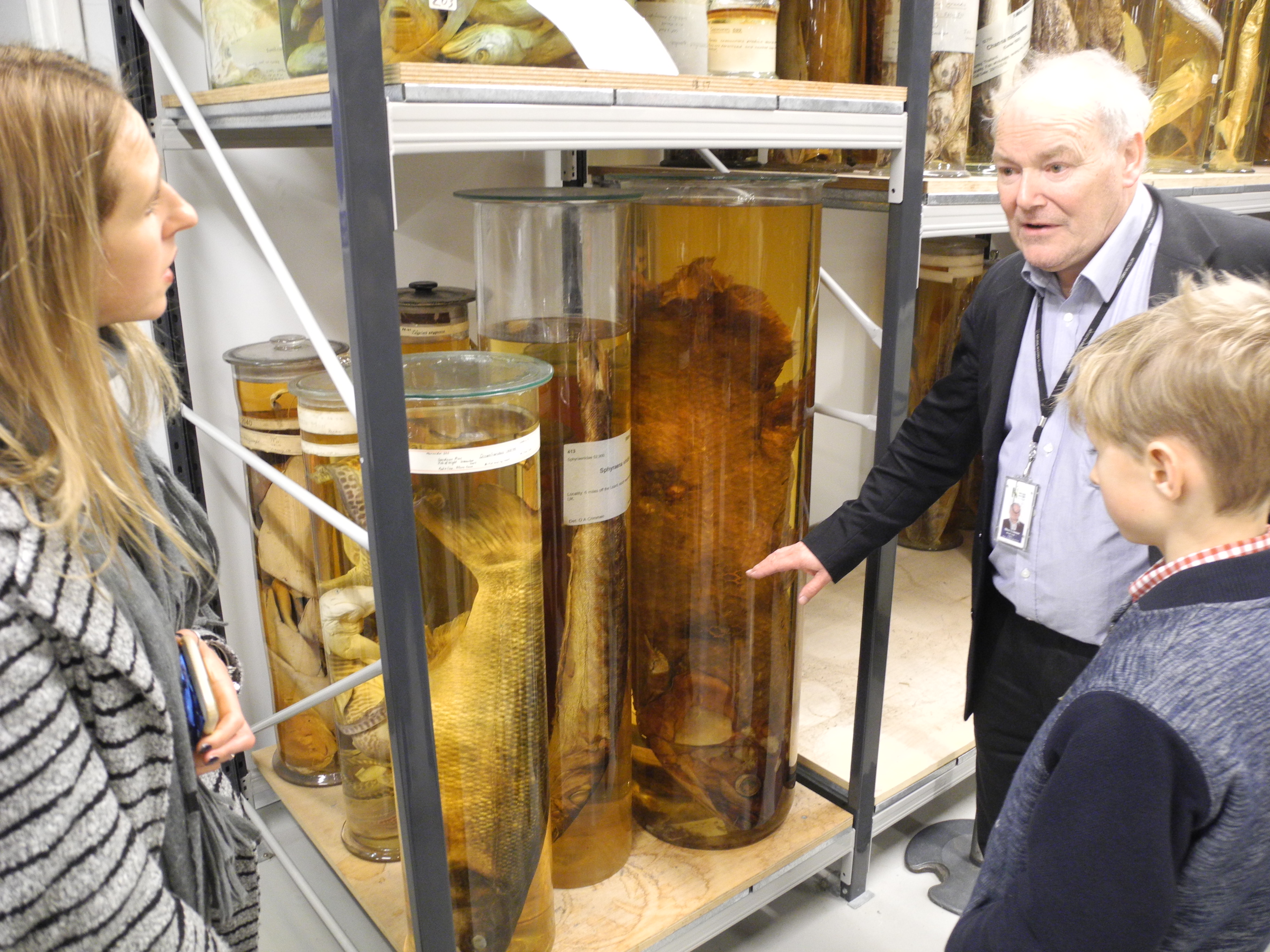
After the two-hour tour of the museums vast and mysterious archives the public viewing area seemed an anti-climax. The huge blue whale cast and numerous stuffed creatures are certainly impressive but nothing could match the experience we had been given behind the scenes.
It was a privilege to meet with Ollie Crimmen and listen to his vast range of stories relating to fish and the world in which they live. A world that we as anglers go prospecting in each time we cast a line. Who knows what mystery could be revealed on that next cast into the underwater world.
Keith and I would also like to thank Chris Vaughan for giving us this unique and unforgettable experience.
 The tackle shop located in Queens walk arcade just off the car park in Bear Street Barnstaple has an extensive range of bait and tackle from popular brands including Korda, Drennan, ESP, Guru, North Devon Company Lakebed Leads, Mainline Baits and Sticky Baits.
The tackle shop located in Queens walk arcade just off the car park in Bear Street Barnstaple has an extensive range of bait and tackle from popular brands including Korda, Drennan, ESP, Guru, North Devon Company Lakebed Leads, Mainline Baits and Sticky Baits.